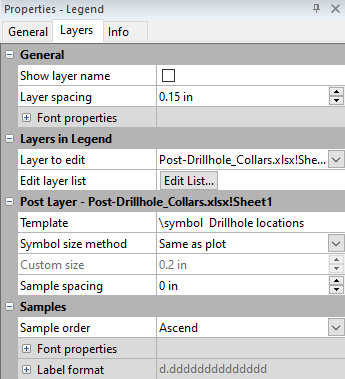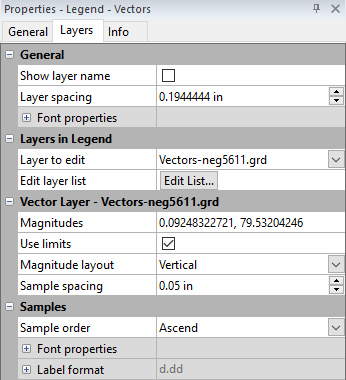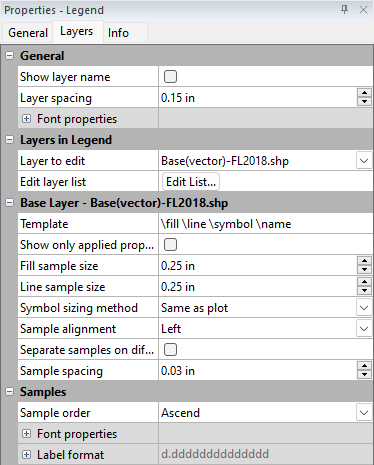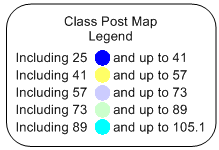Legend Layers Properties
The Layers page in the Properties window controls which layers are included in the legend and the appearance of the legend.
| Layers page for a post layer legend | Vector layer legend. | Unique Values Layers legend. |
|
|
|
|
|
The Layers page controls which layers are included in the legend and the legend sample appearance. |
||
General
The General section contains options for the display of layer names in the legend.
Show Layer Name
Check the Show layer name check box to display layer names above the layers' samples in the legend. Clear the Show layer name check box to display only samples in the legend.
Layer Spacing
The Layer spacing property sets the spacing between the layers in the legend in page units.
Font Properties
Expand the Font properties to control the font properties for the layer names in the legend. All of the layer names use the same font properties.
Layers in Legend
The Layers in Legend section controls which layers are included in the legend, the legend layout, the order of the layers in the legend, and which layer's samples are being edited in the Layer section below.
Layer to Edit
The Layer to edit selection determines which layer is moved by the Layer position property and which layer's properties are displayed in the Layer section. Click the current selection in the Layer to edit field and select the layer you wish to edit from the list. The list includes all of the layers in the legend.
Edit Layer List
Click Edit list in the Edit layer list field to add and remove layers in the legend with the Layers for Legend dialog. The Layers for Legend dialog can also be used to rearrange the layers in the legend.
Layer Layout
Change the overall layout of the legend by selecting Vertical or Horizontal in the Layer layout property field. The Layer layout property is only available when the legend contains two or more layers. Select Vertical to display layers arranged top to bottom. Select Horizontal to display layers arranged left to right. The Layer layout selection controls the buttons in the Layer position field.
Layer Position
The Layer position field changes the position of the Layer to edit selection. When Layer layout is set to Vertical, click Move Up to move the layer up one position in the legend, and click Move Down to move the layer down one position in the legend. When Layer layout is set to Horizontal, click Move Left to move the layer one position to the left in the legend, and click the Move Right button to move the layer one position to the right in the legend. You can also rearrange the layers in the Layers for Legend dialog.
Layer Section
The Layer section contains the properties for the appearance of the samples for the Layer to edit selection. The Layer section name includes the layer type and layer name formatted as <Type> Layer - <Layer Name>, for example Post Layer - Post-Drillholes_Collars.xlsx!Sheet1 . The properties in the layer section depend on the layer type: post, classed post, 1-grid vector, 2-grid vector, or base.
Post, Classed Post, and Base Symbology Properties
The following properties are available when a post, classed post, or base layer is selected in the Layer to edit field.
Variable Layout
The Variable layout property controls the display of the size and color samples when both are displayed on the legend for a post layer. Proportional sizing must be used on the post layer, and a color column must be used with the Numeric via colormap color method to display both size and color samples in the legend. Set the Variable layout property to Horizontal to display the size and color samples side by side. Set the Variable layout property to Vertical to display the size samples above the color samples.
The Variable layout property is only available for the post layer legend.
Number of Samples
Set the number of samples for legend with the Number of samples property. The Number of samples controls both the size and color samples sections in the post layer legend. Type the desired number of samples in the Number of samples field or click the  to change the value.
to change the value.
The Number of samples property is available for post layer, unclassed colors symbology, and unclassed symbols symbology legends.
Template
The Template box customizes the format of the legend items. The specified template is applied to each class or sample in the legend. Normal text and math text instructions can be included within the template, in addition to the following special legend template directives:
| Directive | Post | Classed Post | Unique Values | Unclassed Colors | Unclassed Symbols | Classed Colors | Classed Symbols | Pie Chart |
|---|---|---|---|---|---|---|---|---|
|
\fill |
|
|
fill sample |
color sample |
|
color sample |
|
color sample |
|
\line |
|
|
line sample |
|
|
|
|
|
|
\lower |
|
lower class limit |
|
|
|
|
|
|
|
\name |
|
class name |
|
|
|
class name |
class name |
|
|
\symbol |
symbol sample |
symbol sample |
symbol sample |
|
symbol sample |
|
symbol sample |
|
|
\upper |
|
upper class limit |
|
|
|
|
|
|
|
\value |
sample value |
|
sample value |
sample value |
sample value |
"<= " upper class value |
"<= " upper class value |
sample value |
Any number of directives can be included in any order. The \tab directive can be included to insert a 0.25 inch tab character. As an example, the following template: Including \lower \symbol and up to \upper produces a classed post map legend that looks like:
|
|
|
A sample classed post map legend shows classes, symbols, and text in the class lines. |
Symbol Size Method
The Symbol size method sets the size of the legend symbols. The Symbol size method property is only available for post and classed post layer legends.
- Selecting Based on font causes the symbols to be drawn using the size specified in the Samples section.
- Selecting Same as plot draws the symbols the same size as they appear on the map. This can cause symbols for different classes to be different sizes in a classed post layer legend. It's recommended you use Same as plot in the legend for a post layer with proportional symbol sizing.
- Selecting Custom allows a size to be entered for the legend symbols in the Custom size option.
When a legend is created for a post layer with proportional sizing, the Symbol size method is automatically set to Same as plot . Unclassed symbols and classed symbols symbology legends always display the symbols the same size as in the plot.
Fill Sample Size
The Fill sample size property controls the size of the fill sample square in the legend. Fill samples are available for base layers with unique values, unclassed colors, or classed colors symbology. Specify a size for the fill sample square by typing a value in page units in the Fill sample size field.
Sample Spacing
The Sample spacing property controls the spacing between samples. The Sample spacing can be set independently for each layer in the legend. Type a value in page units in the Sample spacing field to specify the space between legend samples.
1-Grid Vector and 2-Grid Vector Properties
The following properties are available when a 1-grid vector or 2-grid vector layer is selected in the Layer to edit field.
Magnitudes
If you would like to display different vector lengths in the legend, enter the new lengths in the Magnitudes box. The new vectors are scaled relative to the scaling set on the Scaling page in the vector map properties. You can display more than two vectors in the legend by entering a string of numbers separated by commas or spaces into the Magnitudes box. For example, 0.5, 10, 25, 50 would show four symbols in the vector legend.
Use Limits
If the Use limits box is checked, only two vectors are displayed in the vector length legend. These are the Minimum and Maximum values set on the Scaling page in the Magnitude (data) section. When checked, the Magnitudes property and legend will update to show the new values when the Magnitude (data) changes.
Magnitude Layout
The Magnitude layout options align the symbols vertically or horizontally in the legend. To change the Magnitude layout, click on the current option. Select either Vertical or Horizontal in the list.
Unique Value Properties
The following properties are available when Unique Values vector layer is selected in the Layer to edit field.
Show only applies properties
The Show used properties only option is designed to optimize legend presentation. When enabled, this feature filters the legend to display only those properties actively associated with features within the base layer.
Fill sample size
Set the size of the fill sample box displayed in the legend.
Line sample size
Set the length of the line sample, independent from the fill sample size.
Symbol sizing method
The Symbol sizing method setting allows you to customize how symbols appear in the legend. You have two choices:
-
Same as plot makes the symbol size in the legend identical to the size used in the map itself.
-
Fixed set a specific size for the symbols in the legend, independent of their size on the map. This can be useful for making symbols more visible or prominent in the legend
Sample alignment
Use the alignment options to control how samples (fills, lines, and points) are positioned within the legend column. Choose Left, Center, or Right alignment (Center is the default).
Separate samples on different rows
Checking the Separate samples on different rows box separates the polyline, sample fill, and symbol into separate lines in the legend. In the Template field this is analogous to adding a line break before the \line, \fill, and \symbol directives. This means that additional directives are required in the Template field to ensure that each line is labeled appropriately.
|
Separate Samples unchecked |
|
|
Separate Samples checked |
|
|
Separate Samples checked and template adjusted |
|
Sample spacing
The Sample spacing option controls the vertical distance between lines of text in the legend. Increasing the spacing can improve readability and visual appeal.
Samples
The Samples section contains the options for the sample order within layers, and the sample font and label format properties.
Sample Order
The Sample order property specifies whether the samples are listed in ascending order (from smallest to largest) or descending order (from largest to smallest). Click the current selection and select Ascend or Descend from the list. The Sample order applies to the samples in all layers in the legend.
Font Properties
Control the sample font properties in the Font properties section. The font properties apply to the samples in all layers in the legend.
Label Format
Control the sample label format in the Label Format section. The label format properties apply to the samples in all layers in the legend.






